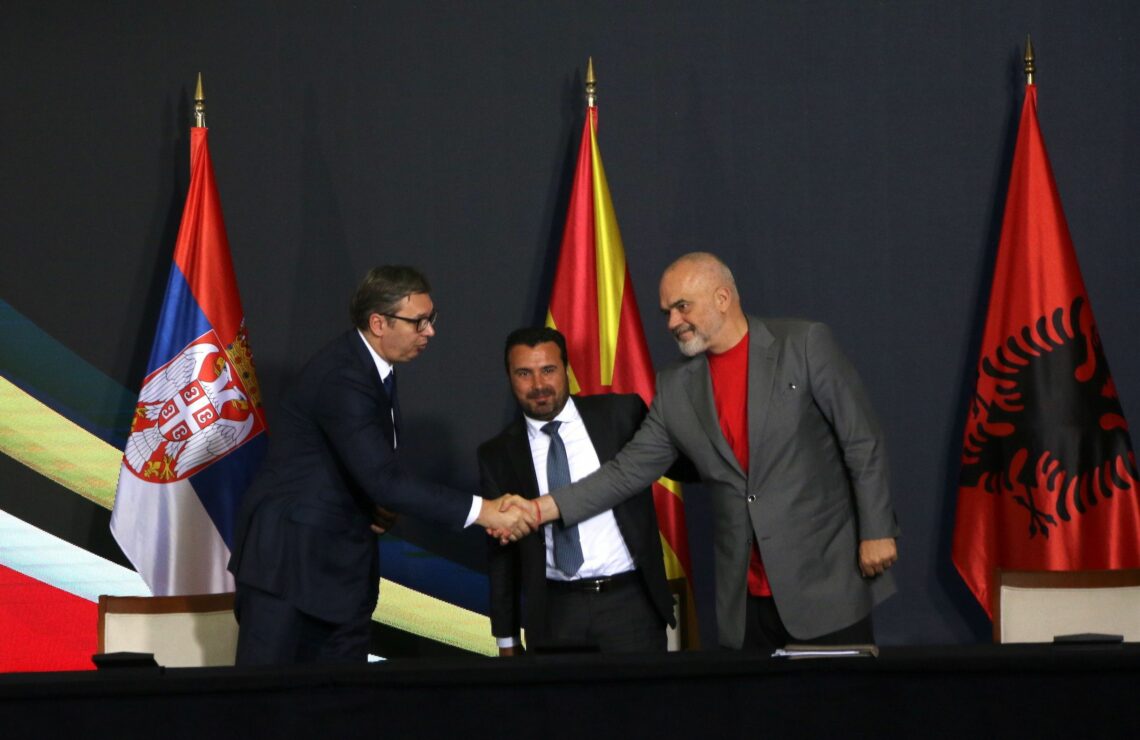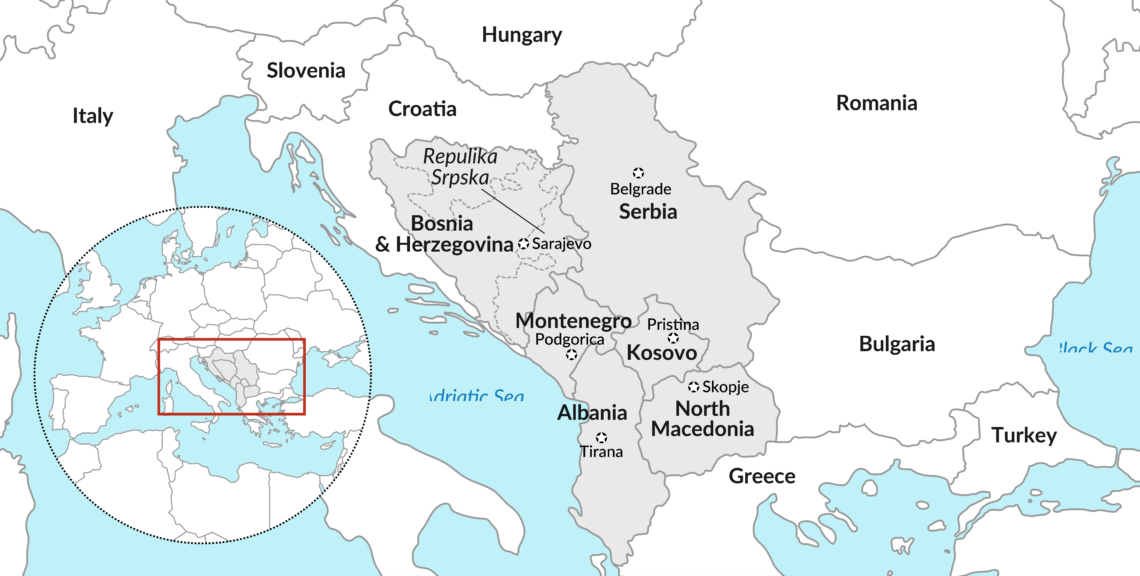Postwar geopolitics – three decades later
Thirty years after the dissolution of Yugoslavia, Serbia is attempting to move toward a new kind of Balkan alliance. But divisions over the recognition of Kosovo and over strategic orientations toward Russia and NATO are hard obstacles to overcome.

In a nutshell
- Serbia seeks to unify the Balkans under its influence
- Divisions over Kosovo and Russia will spoil its designs
- Genuine integration would bring together all regional states
This summer marked three decades after the dissolution of the former Yugoslavia. During the Cold War, it served as a buffer zone between East and West. But after the fall of the Berlin Wall, the last state of southern Slavs came to an end.
It was a historical experiment to create a Yugoslavia without “Yugoslavs.” An artificial creation, it tried to keep different ethnic, religious, and linguistic communities together, ruled centrally from Belgrade. Around 20 million people from different national backgrounds (including historical enemies), lived in an imagined “harmony.” In reality, many were suppressed under a Serbian monarchic dictatorship between two world wars, under Tito’s authoritarian rule after World War II, and under the Milosevic regime during its last decade.
Through his foreign policy of a nonaligned “third bloc,” Tito sold a narrative to both the West (that it would not fall under the Soviet sphere of influence) and to Moscow (that it was neutral to the West). Today, Serbian president Aleksandar Vucic is pushing a version of the same agenda, announcing a summit on October 11-12 of that “nonaligned movement” on its 60th anniversary in Belgrade. However, given the region’s strategic and political fault lines, the latest incarnation of a Serbia-led alliance is likely to meet the same fate as its predecessors.
Facts & figures

Facade of stability
After Tito’s death in 1980, the former Yugoslavia entered into a deep economic and political crisis. Financially, the country had an unpaid international debt of around $20 billion. The “economic stability” of the Yugoslav state, which had survived on foreign credit, was shown to be a facade. According to the World Bank, at the beginning of the 1980s, the Yugoslav gross domestic product (GDP) was $70 billion; bigger than Greece ($57 billion), Romania ($46 billion) and Bulgaria ($18 billion). Later, European Union membership of these latter countries improved their economies: by 1987, Greece had the largest GDP in the region, while in 2016 Romania could claim the largest GDP among the former Balkan communist countries.
Negotiations left most parties feeling that the lion’s share was still given to Belgrade.
Slovenia, as the most developed federal constituent of the former Yugoslavia, had a GDP of $17 billion in 1990; the northwest republic was the first to seek independence from Yugoslavia, after years of colonial maltreatment by the central government in Belgrade. Similarly, the southern federal constituent Kosovo, although less developed in the former Yugoslavia, was the richest in two key elements for its industry: minerals (extracted by the mining companies Trepca, and Feronikel) and energy (at the Obiliq power plant). Before the dissolution of Yugoslavia, the main slogan in Kosovo was: “Trepca works, Belgrade builds.”
Serbia’s absorption of all incomes from all other six federal republics created political dissatisfaction, followed by self-determination movements. After Tito’s death and the fall of the Berlin Wall, circumstances changed, and the federal units sought independence.
Then, after the state’s dissolution, the main question was how to share its assets. More than two decades after the end of the former Yugoslavia, a long negotiation process left most parties feeling that the lion’s share was still given to Belgrade. Furthermore, Kosovo was not allowed to be part of the distribution, even though for half a century it had contributed to the Yugoslav economy with metals and energy.
What happened after the creation of these new states, and what is their standard today? The economic picture turns out to be similar to that of three decades ago: the two northwest ex-republics, now EU members, have the highest average monthly salaries (Slovenia at 1,100 euros and Croatia at 866 euros). Meanwhile, Montenegro stands at 511 euros; Bosnia and Herzegovina at 450 euros; Serbia at 424 euros; North Macedonia at 399 euros, and Kosovo at 374 euros.
The end of the Yugoslav experiment
The 1990s saw the beginning of the end of communism in the East, and the end of the Yugoslav state. For the Serbs, it was the end of their dominance in that federation. But for Albanians – the third-biggest nation – it was the end of a collective prison, where every third Albanian was arrested or jailed for political reasons, and while many who were not in jail were expelled. Communist Yugoslavia in the 1950s continued to massively expel Albanians to Turkey, as monarchic Yugoslavia had done in the 1930s. Others escaped from that repressive regime to the West, mostly to the United States and elsewhere in Europe. (This explains why today more Albanians live abroad than in the Balkans.)
Eight decades of Serbia’s “Yugoslav idea” created three Yugoslav states under Serbian dominance: the first from 1918 to 1941, a second from 1945 to 1991, and the third from 1992 to 2006. The first two followed geopolitical changes after the Versailles Peace Treaty (1919) and the Paris Peace Treaty (1945); the third was the last attempt at reincarnating a state that had failed twice. But in 2006, geopolitical circumstances changed radically, and after the separation of Montenegro from “Federal Yugoslavia,” that idea began to appeal to Serbia again.
The dissolution of the last Yugoslavia came after the changes that ended the Cold War. The former state, defended by two opposite poles, no longer held geostrategic importance. Slobodan Milosevic’s plan to transform Yugoslavia into “Serbo-Slavia” provoked internal political turmoil, speeding the process of dissolution. With the Yugoslav army, he started new wars – in June 1991 in Slovenia, and later in Croatia, Bosnia and Herzegovina and Kosovo – hoping for support from the former Soviet Union. But he had forgotten that the Cold War era was over.
Regional gathering
After these liberation wars, seven new states were created. Today, two of them are members of the EU, three more are on the path to EU integration, and two are waiting for EU candidate status; while four of the seven are also in NATO. Other than Serbia, which is militarily allied with Russia and economically dependent on China, all are clearly oriented toward the West.
But 30 years since the end of the Yugoslav federation, Serbia is again pushing its vision of Balkan unification, aiming to reincarnate the former Yugoslavia with its former federal constituents plus Albania. On October 10, 2019, a Balkan “Mini-Schengen” area was launched at a meeting in Novi Sad between Serbian President Aleksandar Vucic, Albanian Prime Minister Edi Rama and North Macedonian Prime Minister Zoran Zaev.
While two meetings followed that year in Albania and North Macedonia, no progress was marked until recently, when the project was relaunched on June 28, 2021, by the three nations. At a July 29 meeting in Skopje, the initiative was renamed the “Open Balkans.”(Meanwhile, also in July, Serbia acceded to the Eurasian Economic Union – a Russia-dominated economic area.)
Three other states – Montenegro, Kosovo and Bosnia and Herzegovina – have not participated in the Open Balkans talks, rejecting the initiative over fears of a “new Yugoslavia.” Kosovo in particular has refused because it is not recognized by Serbia, and because it opposes replacing EU integration with regional integration.
Serbia’s project is likely to be the fourth failure of the Yugoslav idea.
After World War II, the Benelux Union and the European Coal and Steel Community were created, but these were regional integrations of mutually recognized states. This is not the case with the new Serbian project, which has not addressed the crucial question of how “regional integration” will function if Belgrade does not recognize Kosovo.
The Skopje meeting in July, where the vision of a Mini-Schengen Area became a three-state Open Balkans, was the end of those grander ambitions. After three years, eight meetings and the refusal of three other countries, that idea appeared unworkable. How could regional integration succeed if the region’s countries have different strategic orientations, and included an anti-NATO Serbia allied with Russia along with three NATO members (and one with NATO presence inside its borders)? While five of these states are working toward Euro-Atlantic integration, Serbia has opted for Russia’s Eurasian Economic Union.
Before Serbia’s 2019 launch of the Mini-Schengen, similar regional integration projects had included the annual summits between the presidents of Kosovo, Albania, North Macedonia and Montenegro, since 2008; “The Western Balkan 6” initiative of 2011; or Tirana’s “Balkan Benelux” initiative of 2012. All these projects were refused by Serbia, leaving the other five states asking why they should accept a new program from the country that had spurned them. In renaming the Mini-Schengen to the Open Balkans, Mr. Vucic did not alter the essence of his vision: the whole of the Balkans as part of a “Serbian World” (“SrpskiSvet”), a new strategy inaugurated last year.
The European idea of moving from reconciliation to integration created today’s EU. But Serbia has never apologized for the genocide of the Milosevic regime, during the last wars in the Balkans. As German Chancellor Angela Merkel said in the last meeting of the Berlin Process on July 5, “the Balkans needs reconciliation.”
But how can regional integration of the Western Balkans progress when Serbia has not recognized Kosovo, and exercises undue influence in Bosnia and Herzegovina through Republika Srpska? In a July 31 statement, the EU clearly said that any regional cooperation initiative should include all six countries of the Berlin Process, based on the “action plan” for a Common Regional Market further developed at the July 5 summit.
Belgrade is trying to sell the fourth “regional” project of Serbian hegemony. But it is more likely to be the fourth failure of the Yugoslav idea of the last century.
Scenarios
A reincarnation of Yugoslavia is improbable, even with the newly renamed initiative of the Open Balkans. Such trilateral gatherings will not survive because they do not represent true regional integration, but an agreement among half the Balkans countries.
Most likely, the Balkans will continue to be divided strategically in two geopolitical blocs: the pro-Russia alliance of Serbia and Republika Srpska, and the Euro-Atlantic alliance of Albania, North Macedonia, Kosovo, Montenegro and Bosnia and Herzegovina (minus Republika Srpska). It is also unlikely that NATO would allow its allies to join a would-be Russian-oriented Balkans.








